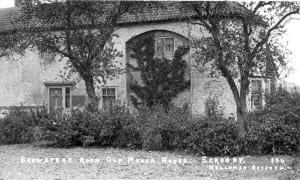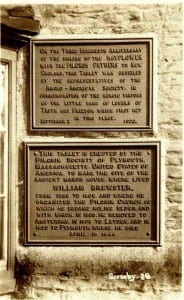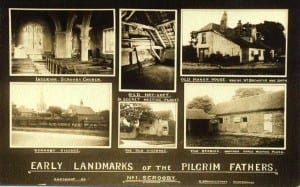Scrooby in Nottinghamshire was the home of Pilgrim elder William Brewster, before he fled to Holland with the Separatist congregation from north Nottinghamshire, and then later sailed to America on the Mayflower to found a colony in Plymouth, Massachusetts.
His home in Scrooby was the Manor House, where his father held the position of Master of the Postes, at a point mid-way along the Great North Road that stretched through the country from London to Edinburgh.
A photo in the Bassetlaw Museum’s Welchman Archives purportedly shows his room:

- Sepia print. Brewster’s Room – Old Manor House, Scrooby. Taken about 1910.
- From the Welchman Archive, Bassetlaw Museum [Photograph number RETBM : 1988.1322]
Plaques have been placed on the walls on this old house by visiting Americans to commemorate Brewster and William Bradford, the second Governor of Plymouth colony, who came from nearby Austerfield:

B/w print. Scrooby. Plaque commemorating 300th anniversary of the sailing of the Mayflower, erected September 2 1920 and tablet erected by the Pilgrim Society about William Brewster. From the Welchman Archive, Bassetlaw Museum [Photograph number RETBM : 1999.3].
The plaques read as follows:
“On the Three Hundredth Anniversary of the sailing of the Mayflower with the Pilgrim Fathers to New England, this tablet was unveiled by the representatives of the Anglo-American Society, in commemoration of the heroic virtues of the little band of lovers of Truth and Freedom which first met in this place. September 2, 1920.”
“This tablet is erected by the Pilgrim Society of Plymouth, Massachusetts, United States of America, to mark to the site of the ancient manor house, where lived William Brewster, from 1588 to 1608, and where he organized the Pilgrim Church of which he became ruling elder, and with which, in 1608, he removed to Amsterdam, in 1609 to Leyden, and in 1620 to Plymouth, where he died April 16 1644.”
Do you know anyone who has travelled from America and visited these or other commemorative Pilgrims’ plaques? Have you been part of a group who has dedicated a plaque about Pilgrims’ heritage? Do you think it is important to remember the Pilgrims through dedicated plaques, monuments or memorials? If you would like to talk more about your stories you can contact me through the blog, or on facebook or twitter @annaruthscott, or email me at anna.scott@students.lincoln.ac.uk.
The following postcard from the 1920s depicts various scenes in Scrooby that were linked at this time to the story of the Separatists:

B/w print. Scrooby. Montage of six views titled ‘Early landmarks of the Pilgrim Fathers, No 1 Scrooby’. The views include the interior of St Wilfrid’s Church, Old Hay-loft, Old Manor House, The Stables, The Old Vicarage and Scrooby village. Taken about 1920. From the Welchman Archive, Bassetlaw Museum [Photograph number RETBM : 1999.3431].
In 1957, the people of Scrooby sent a scroll to America on the replica ship, Mayflower II:

B/w print. Photograph of the scroll sent to U.S.A. aboard Mayflower II, 1957. Signed by church and parish council members of Scrooby. From the Welchman Archive, Bassetlaw Museum [Photograph number RETBM : 1988.1336].
“We the undersigned, representing the Ecclesiastical and Civic Authorities of the Ancient Parish of Scrooby in the County of Nottingham, herewith send over cordial good wishes to the Captain, Crew and Passengers of Mayflower Two, and, to the descendants of those citizens of Scrooby and neighbourhood who left our English shores for the United States of America in Mayflower One in the year A.D.1620.
As a community we are proud of these historic associations, gladly welcome visitors from the United States at all times and are conscious of the interest and help given to our Ancient Township throughout the years. Our heartfelt wish is that this interchange of interest and co-operation may be still more firmly established in all the years that lie ahead.
Signed this Twenty-eighth day of March in the year One thousand nine-hundred and fifty-seven.”
Text from the Scrooby Scroll, 1957



